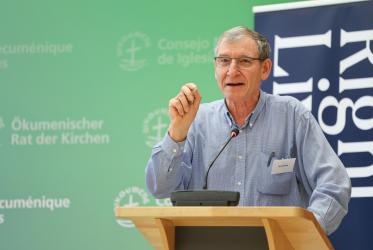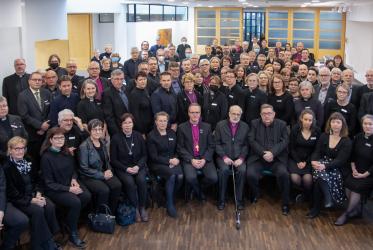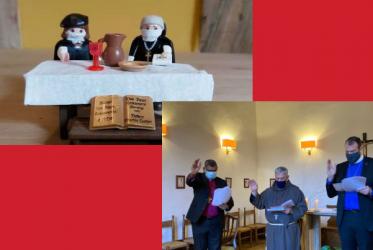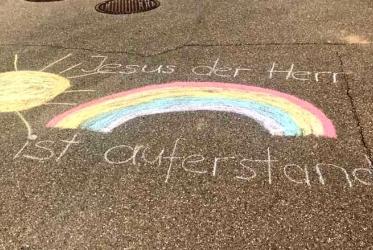In 2018 we celebrate the 70th anniversary of the World Council of Churches. In order to create a lively firsthand account of the ecumenical fellowship and of our shared journey, member churches have contributed stories of people, events, achievements and even failures, all of which have deepened our collective search for Christian unity.
This story was written by Ray Williamson Oam, co-founder of the Centre for Ecumenical Studies in Australia.
Any views or opinions expressed in this article are those of the author, and do not necessarily reflect the policies of the World Council of Churches.
The most significant ecumenical initiative in Australia following the formation of National Council of Churches in Australia (NCCA) in 1994 was the signing of the National Covenanting Document in 2004.
When formed, the NCCA replaced the former national ecumenical body, the Australian Council of Churches, bringing into membership the Roman Catholic Church for the first time, and also being in conversation with the Lutheran Church of Australia with a view to membership (achieved in 1998).
At such a time of ecumenical renewal, the newly established NCCA Faith and Unity Commission naturally gave thorough consideration to the most recent international statement on unity – the Canberra Statement – and its implications for the life of the churches in Australia: how could the churches be challenged and assisted in giving greater expression to the commitment they had made to each other in forming the NCCA?
Koinonia & local covenanting
The commission also was able to draw on some knowledge and experience of the Local Ecumenical Partnerships in England and the covenants on which they were based, and thus began to develop a proposal to take to the churches for the formation of a National Covenant in Australia. This would serve two purposes. First, it would signify an ongoing commitment by the churches nationally to take further steps towards greater visible expressions of unity, to move towards a deeper experience of communion (koinonia). Second, it would be “permission-giving”, providing a model for local churches to enter into covenants with one another, as the nature of the agreement between any two churches nationally would open possibilities, provide guidelines, and give encouragement to their congregations to covenant together locally.
Questions for reflection
It was recognised that the development of a national covenant would take time and that the Commission would need the agreement of the churches to proceed with it. Consequently, the Commission reported to the 1996 NCCA National Forum and sought permission to address questions to the member churches for reflection and response to provide the basis on which specific proposals for covenanting could be developed.
These questions were:
- In the light of the Canberra Statement, what has been achieved since the 1991 World Council of Churches (WCC) Assembly?
- What specific steps will your church take in the next five years towards realising a more visible unity?
- What specific steps will your church consider taking towards the attaining of this purpose in subsequent three-year periods?
- What specific steps would you encourage other churches to take towards the same goal?
The ensuing communication to the churches sought to guarantee that these matters were discussed at the highest level in each church and asked for ideas and advice, “from the concretely practical to the more creatively imaginative”.
Multidimensional
The responses from the churches were not numerous but they were substantial, interesting and sometimes surprising in content. It was these replies together with another document, “Being Church in Rural Queensland”, that the Commission had to guide it in shaping a national covenant. It was clear from these sources, as well as from knowledge of the diversity of the English local covenants, that a covenant for Australian churches needed to be multidimensional. Such a covenant would provide flexibility, would be realistic about the different possibilities for churches in their current relationships with each other, and so would enable the churches to enter the covenant in those dimensions on which they could presently agree – while at the same time opening the churches to the idea of “what might be possible if they went to the limits of what is permissible”.
Extensive consultation
A proposal for such a covenant was therefore taken to the 1998 National Forum, with the acknowledgement that the process would be “demanding, requiring diligence and sensitivity”, but also one that was “worth the effort given its potential for ecumenical renewal”. From the Forum came permission to proceed in consultation with the churches, and encouragement to the member churches to engage in dialogue with each other while respecting each other’s constraints and disciplines, in order to develop the proposed covenant into a final document for agreement at the National Forum three years hence.
Because of the many and varied possibilities for cooperation and commitment between the churches, they were urged to talk with one another on a one-to-one basis during the ensuing months, and to facilitate this, it was suggested that the matter be placed immediately on the agenda of the national bilateral dialogues. Thus, the intervening period was marked by extensive consultation to give every opportunity to engage the churches in preparing for covenanting, and in 2001 the commission offered another document, “In Preparation for Covenanting”, to facilitate further conversations between the churches.
In addition, to support the process in a different way, the Commission produced a video, Portraits of Unity, that told stories of existing local covenants and other examples of cooperation in Australia, to be a resource to raise awareness of the possibilities for covenanting locally, and to stimulate the imagination as churches, both nationally and locally, responded to the invitation to explore the options for entering into a multidimensional covenant together.
Consequently, as the 2001 Forum approached, it was with much anticipation that the agreement of the national Covenanting Document was awaited. It was seen as a hopeful sign, containing great potential and opening possibilities for future ecumenical developments.
Challenges, debate and a turning point
But it was not to be. Many of the churches’ delegates appeared not to know about it beforehand. They were not ready to agree to the kind of commitment that the covenant represented – indeed, it showed that a number of member churches had not done their homework in understanding the full implications of what signing the covenant might mean. The experience underlined the frustration that can easily be felt in a council of churches about communicating with the member churches. It is hard to imagine how that consultative process could have been more extensive, yet at the crucial moment many of those representing their churches at a National Forum of NCCA were unaware of it.
While there were moments during that National Forum when it seemed that the move towards a covenant might be lost, the outcome was much more positive. It marked a turning point when the churches’ leaders became more actively engaged in the process; it saw the adoption of the “Declaration of Intent” – the first part of the Covenanting Document – after a prolonged and thoughtful debate, while the remainder of the document was subjected to a lengthy, useful and complex discussion that resulted in some detailed amendments; and it heard some wonderful new commitments by the churches.
Levels of commitment
The document as it now stood consisted of three parts: the Declaration of Intent; Five Dimensions of Commitment; and a Future Pledge to continue to seek more visible expressions of unity.
The core section of the document contained the opportunity for the churches to enter together into one or more of the five levels of commitment:
- To pray with and for one another and to explore issues of faith together
- To share physical resources and not to begin new initiatives without discussion with others
- To explore issues and strategies for mission with one another and for responding together to needs in the local community
- [a] To recognise the Sacrament of Baptism administered in each other’s churches and to mark that recognition by the use of a Common Certificate of Baptism, and [b] to invite and welcome members of other churches to the Eucharist according to pastoral need
- To continue to work towards the goal of sharing with each other a mutually recognised ordained ministry.
Back to the churches
Subsequently, the revised Covenanting Document was forwarded to the member churches with a request that careful consideration be given to the sections of the document in which the name of the respective churches could appear.
The replies, as they were gradually received, were not all straightforward. Some required further negotiation even up to the eve of the 2004 National Forum. A few required a qualifying footnote to be added to the section where there was an issue for a particular church. For one church, it was the idea of a ‘covenant’ that was the issue; but this was resolved by recognition of the fact that for some time the document had not been called a “Covenant” but “Australian Churches Covenanting Together” in order to emphasise the ongoing nature of the process and to avoid any sense of a finally settled agreement.
Celebration
Therefore, by the time NCCA met in 2004, the endorsement of the Covenanting Document was a formality. The leader of each member church delegation (at the time, 15) signed this concluding statement in the document:
“On behalf of our churches, we affirm our commitment to this covenanting process. At this point in our journey towards visible unity, we confirm those places in this document where the name of our own church appears, as a sign of what we can covenant to do together.”
A liturgical celebration was the only possible response, and this occurred a few hours later. It was the celebration of a very significant moment in the Australian story of ecumenism! It also was an appropriate way to mark the tenth anniversary of the formation of NCCA.
It was a moment for excitement. It also was a moment to be realistic. Some aspects of the covenanting document did no more than reflect existing initiatives. For example, the mutual recognition of baptism was not a new initiative; it had its origin almost 20 years earlier when four, then six, churches had entered into such an agreement.
But other aspects did represent significant steps. Again, using the mutual recognition of baptism as the example, more churches, notably the Armenian Apostolic Church, the Congregational Federation and two additional Eastern Orthodox Churches, entered into this agreement; and the Presbyterian Church, though not an NCCA member church and therefore not a signatory to this document, but one of the six in 1988, agreed still to be a participant in this mutual recognition of baptism. Thus the six from the 1980s had become ten.
A sign of hope
It was a moment of satisfaction, too, because it was a strong indication of the seriousness with which the churches were taking their NCCA membership and their acceptance of the challenge to seek more extensive expressions of their unity in Christ. It was also a sign of NCCA doing its job: the measure of any council of churches is what it enables to happen between the churches to deepen relationships in order to express their unity more visibly.
Furthermore, there have been indications of this Australian document receiving recognition from the wider church: for example, during his visit to Sydney for World Youth Day in 2008, it was brought to the attention of Pope Benedict, who gave due public acknowledgement to it; the ecumenical councils in Scotland and the USA have sought information about it; and it has also received recognition from the WCC.
But most importantly, the great potential of this Covenanting Document is the inherent permission given to local church communities across the country to enter into their own covenanting together. For these reasons the “Australian Churches Covenanting Together” document remains a sign of hope for a better way!
Reception
Following the Forum, the key question regarding the document was about ‘reception’. How and to what extent was it being ‘received’ by the churches? How and to what extent was it affecting the life of member churches at all levels? It was assumed that the Faith and Unity Commission needed to carry the responsibility to nudge and encourage the churches in this reception process.
To that end, through the NCCA Executive, the Commission addressed several questions to the churches:
- What steps are being taken by the member churches to ensure that the Covenanting Document is known, being adopted and acted upon at all levels?
- What targets have been set by your church for the implementation of the endorsed dimensions of the document?
- How have relationships between your church and other churches developed since July 2004?
- How can the member churches, meeting together in the NCCA, be accountable to one another for the implementation of the Covenanting Document?
Living document
For many there was a determination that the document not become dusty on the general secretary’s bookshelves, but should remain a living entity.
Such determination was found in the Faith and Unity Commission. It was diligent in keeping before the churches the challenge of the commitment they had made to each other. It made presentations to the NCCA Executive and facilitated sessions on covenanting and the process of ‘reception’ at both the 2007 and 2010 National Forums.
These opportunities were created for the churches’ representatives to speak with one another about how the signing of the document had made a difference, to encourage one another with reports of ways in which churches had been responding to this invitation to covenant together more locally.
Another sign of the document remaining a living entity has been its growth. Since 2004, the four additional churches that have become NCCA members have also become ‘covenanting’ churches, entering into the commitment as signatories to the document.
So how is “Australian Churches Covenanting Together” to be understood? It is far from an agreement that might be the basis for a merger of two or more churches; nor is it the kind of agreement that comes from the resolution of complex theological differences. Rather, it is an instrument through which the churches can redefine their relationships by decisive mutual action, leading to increased participation in one another’s ecclesial lives.
The document has enabled the churches to look closely at their relationships and it continues to hold before them the possibilities for mutual action that will mark further stages on the ecumenical journey.
Prayer
Eternal and loving God,
you call us into covenant,
into reliable and lasting relationships,
with you and with each other:
through your grace, may we be
constant in our commitment to Christ,
adventurous in our quest for unity with each other, and
authentic in our witnessing to the good news of your love.
In the name of Christ we pray.
Amen.
More information about 70 years of the WCC
Read more WCC 70th anniversary stories
If you would like to tell your own story, please be in touch!






